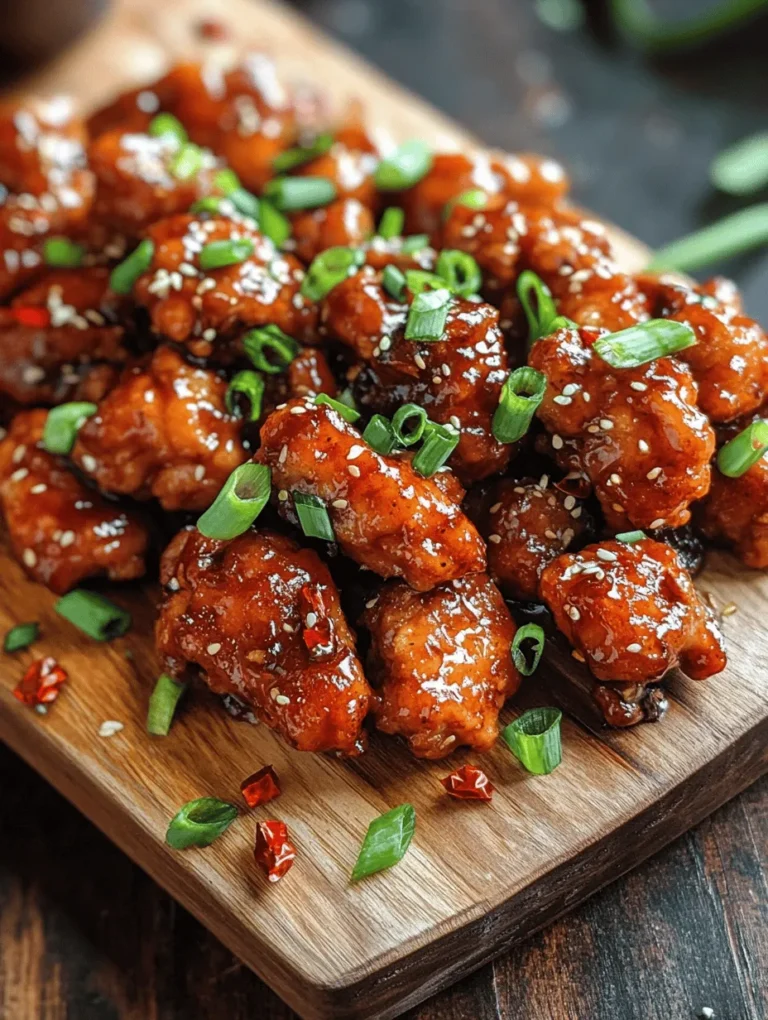Introduction
General Tso’s Chicken is a beloved staple in Chinese-American cuisine, renowned for its sweet, tangy, and slightly spicy profile. This dish has captivated the taste buds of millions, making it a go-to option for takeout and restaurant dining alike. The crispy chicken pieces, coated in a luscious sauce, provide an irresistible combination that keeps food lovers coming back for more. However, while the traditional recipe has its merits, there’s a growing trend of reimagining classic dishes to enhance their flavors and textures, making them even more appealing to contemporary palates.
In this article, we introduce a reimagined version of General Tso’s Chicken that elevates the classic recipe to new heights. Our take includes a buttermilk marinade that tenderizes the chicken while imparting a rich flavor, a perfectly crispy coating that adds crunch to every bite, and a balanced sauce that harmonizes sweet, sour, and savory notes. Whether you’re a seasoned cook or a kitchen novice, this comprehensive guide will equip you with everything you need to recreate this delightful dish at home. Join us on this culinary journey, and let’s transform a beloved takeout favorite into an exceptional homemade experience.
The History of General Tso’s Chicken
To truly appreciate General Tso’s Chicken, it’s essential to delve into its historical roots. The dish is named after General Tso Tsung-t’ang, a 19th-century Chinese military leader known for his strategic prowess. However, it’s important to note that General Tso’s Chicken, as we know it today, has little connection to the historical figure. Instead, it emerged from the creative kitchens of Chinese immigrants in the United States during the late 20th century.
The origins of General Tso’s Chicken can be traced back to Hunan cuisine, which is characterized by bold flavors and the heavy use of chilies. The dish likely began as a fried chicken recipe tossed in a flavorful sauce, but it was adapted over time to suit American tastes. The first recorded recipe appeared in the 1970s, thanks to chef Peng Chang-kuei, who opened a restaurant in New York City. His version was a hit, and it soon spread across the country, becoming a popular menu item in Chinese restaurants nationwide.
Over the years, General Tso’s Chicken has undergone various adaptations, incorporating different ingredients and cooking techniques. From the addition of broccoli to variations in the sauce’s sweetness, each iteration reflects the evolving tastes and preferences of diners. Today, it stands as a symbol of the fusion between Chinese and American culinary traditions, showcasing how food can transcend cultural boundaries while still holding onto its roots.
Ingredient Breakdown
When crafting a reimagined version of General Tso’s Chicken, the choice of ingredients plays a crucial role in achieving the desired flavor and texture. Here’s a detailed breakdown of each component used in our recipe:
Chicken
For this recipe, we recommend using boneless, skinless chicken thighs. Thighs are preferred over breasts for their richer flavor and juicy texture. The higher fat content in thighs ensures that the chicken remains moist during cooking, resulting in tender bites that can stand up to the bold sauce. Additionally, thighs are less likely to dry out, providing a more satisfying eating experience.
Buttermilk
One of the standout elements of our reimagined General Tso’s Chicken is the buttermilk marinade. Buttermilk serves two primary purposes: it tenderizes the chicken and adds a layer of flavor. The acidity in buttermilk breaks down the proteins in the chicken, making it more succulent and flavorful. This marination step is crucial for enhancing the overall taste of the dish, ensuring that each piece of chicken is infused with the rich, tangy notes of the buttermilk.
Dry Coating
Achieving a crispy coating is essential for creating the perfect General Tso’s Chicken. We use a combination of all-purpose flour and cornstarch for the dry coating. The flour provides structure, while the cornstarch contributes to an extra crunch that elevates the overall texture of the dish. The cornstarch forms a light, crispy crust when fried, ensuring that each bite is satisfying. For added flavor, we recommend seasoning the dry mixture with salt, pepper, and a hint of garlic powder.
Sauce Ingredients
The sauce is where the magic happens, bringing together a medley of flavors that define General Tso’s Chicken. Here’s a breakdown of each component:
– Soy Sauce: The backbone of the sauce, soy sauce adds a savory umami flavor that enhances the overall dish.
– Rice Vinegar: This ingredient provides acidity, balancing the sweetness of the sugar and the richness of the chicken.
– Sugar: A key player in achieving that classic sweet-and-sour profile, sugar helps to round out the flavors.
– Hoisin Sauce: Known for its sweet and tangy flavor, hoisin sauce adds depth and complexity to the sauce.
– Sesame Oil: A small amount of sesame oil contributes a nutty aroma and flavor that complements the other ingredients.
– Chili Paste or Sauce: For those who enjoy a bit of heat, adding chili paste or sauce elevates the dish with a kick of spice.
Cooking Oil
Lastly, the choice of cooking oil is important when frying the chicken. We recommend using oils with a high smoke point, such as vegetable oil or peanut oil, to ensure that the chicken gets crispy without burning. Proper oil temperature is essential for achieving that sought-after crunch while keeping the chicken tender inside.
Preparation Steps
Now that we’ve covered the ingredients, let’s move on to the preparation steps that will guide you through making this delightful dish.
Step 1: Marinating the Chicken
Start by cutting the boneless, skinless chicken thighs into bite-sized pieces. Place them in a large bowl or a resealable plastic bag, and pour in the buttermilk. Make sure all the chicken pieces are fully submerged in the marinade. For best results, allow the chicken to marinate for at least one hour in the refrigerator, though overnight is even better. This extended marination time allows the buttermilk to work its magic, tenderizing the meat and infusing it with flavor.
Tips for Effective Marination:
– For added flavor, consider seasoning the buttermilk with a pinch of salt, pepper, and garlic powder before adding the chicken.
– If you’re short on time, even 30 minutes of marination can still yield good results, but the longer, the better.
Step 2: Preparing the Dry Coating
While the chicken is marinating, prepare the dry coating. In a separate bowl, combine equal parts all-purpose flour and cornstarch, along with salt, pepper, and any additional seasonings you prefer. Mix well to ensure that the spices are evenly distributed throughout the dry mixture.
Step 3: Heating the Oil
In a deep skillet or heavy-bottomed pot, pour enough oil to submerge the chicken pieces about halfway. Heat the oil over medium-high heat until it reaches approximately 350°F (175°C). Use a thermometer for accuracy; maintaining the right temperature is crucial for achieving that crispy texture.
Safety Tips:
– Always be cautious when working with hot oil. Avoid overcrowding the pan, as this can lower the oil temperature and result in soggy chicken.
– Keep a close eye on the oil temperature, adjusting the heat as needed to maintain a steady frying temperature.
Step 4: Frying the Chicken
Once the oil is hot, remove the marinated chicken from the refrigerator. Allow any excess buttermilk to drip off before dredging the chicken pieces in the dry coating mixture. Ensure each piece is thoroughly coated, shaking off any excess flour.
Carefully place the coated chicken pieces into the hot oil, working in batches if necessary to avoid overcrowding. Fry until golden brown and cooked through, usually about 4-6 minutes, depending on the size of the pieces. Use a slotted spoon to transfer the fried chicken to a paper towel-lined plate to drain excess oil.
—
With these initial steps, you are well on your way to creating a stunning reimagined version of General Tso’s Chicken that will impress family and friends alike. Stay tuned for the next part of this article, where we will delve into the final touches, including making the sauce and assembling the dish for a delightful presentation.
Frying the Chicken: Best Practices for Even Cooking and Avoiding Sogginess
Frying the chicken for General Tso’s Chicken is crucial for achieving that perfect crispy texture. To ensure even cooking, start by using chicken thighs or breasts cut into uniform bite-sized pieces. This uniformity allows for consistent cooking, preventing some pieces from being overcooked while others are underdone.
Preparation for Frying:
1. Marinate the Chicken: Prior to frying, marinate the chicken pieces in a mixture of soy sauce, rice wine, and egg for at least 30 minutes. This not only enhances flavor but also helps create a protective barrier that keeps the chicken moist during frying.
2. Dredging: In a shallow dish, combine cornstarch and flour in a 1:1 ratio. Dredge each piece of marinated chicken thoroughly, shaking off excess. This coating is essential for achieving a crispy outer layer while maintaining juiciness within.
3. Oil Temperature: Heat vegetable oil in a deep pan or wok to 350°F (175°C). Use a kitchen thermometer for accuracy. If the oil is too hot, the chicken will cook too quickly, leading to a burnt exterior and raw interior. Conversely, oil that is not hot enough will result in soggy chicken.
4. Frying in Batches: Fry the chicken in batches, ensuring not to overcrowd the pan. This maintains the oil temperature and allows for proper frying. Cook each batch for about 4-5 minutes until golden brown and crispy. After frying, place the chicken on a wire rack set over a baking sheet to drain excess oil, which keeps it crisp.
Crafting the Sauce
The sauce is where the magic of General Tso’s Chicken truly happens. It transforms the fried chicken into a flavorful dish that balances sweet, savory, and spicy notes.
Detailed Instructions on Making the Sauce
1. Cooking Aromatics: Begin by heating a small amount of oil in the same pan used for frying the chicken. Add minced garlic and ginger, sautéing them over medium heat until fragrant, about 30 seconds. These aromatics are essential as they form the foundation of the sauce, enhancing its depth of flavor.
2. Combining the Sauce Ingredients: In a bowl, whisk together soy sauce, rice vinegar, sugar, and hoisin sauce. The sugar adds sweetness, while the vinegar provides acidity to balance the dish. Hoisin sauce brings a hint of complexity with its rich, sweet, and slightly spiced profile. Adjust the proportions to taste, increasing the vinegar for more tang or the sugar for additional sweetness as preferred.
3. Thickening the Sauce: To achieve the desired consistency, mix cornstarch with a small amount of water to create a slurry. Once the aromatics are cooked, pour in the sauce mixture and bring it to a simmer. Gradually add the cornstarch slurry, stirring continuously until the sauce thickens, which should take about 1-2 minutes. This thickening process is crucial as it helps the sauce cling to the chicken, ensuring every bite is flavorful.
Bringing It All Together
With the chicken fried and the sauce prepared, it’s time to combine these elements for the final dish.
Final Steps for Completing the Dish
1. Tossing the Fried Chicken in the Sauce: In a large mixing bowl or directly in the pan, add the fried chicken pieces. Pour the thickened sauce over the chicken, tossing gently to coat each piece evenly. This step is vital; using a spatula can help lift and coat the chicken without breaking it apart.
2. Presentation Ideas: For a visually appealing presentation, serve the General Tso’s Chicken on a large plate or a shallow bowl. Garnish with sliced green onions and sesame seeds for added color and texture. A sprinkle of red pepper flakes can also enhance the dish’s spiciness and visual appeal.
Serving Suggestions
To create a complete meal, consider these complementary side dishes that pair perfectly with General Tso’s Chicken:
– Steamed Rice: A classic accompaniment that soaks up the delicious sauce. Jasmine or white rice works best, but brown rice can be used for a healthier option.
– Fried Rice: For a heartier side, fried rice with vegetables and scrambled eggs adds flavor and texture, making it a filling meal.
– Stir-Fried Vegetables: A mix of bell peppers, broccoli, and snap peas stir-fried in sesame oil adds color and nutritional balance to the dish.
Beverage Pairings:
– Tea: A hot or iced green tea complements the dish’s flavors without overwhelming the palate.
– Beer: Light lagers or pale ales can enhance the meal’s enjoyment, offering a refreshing contrast to the savory flavors.
– Cocktails: Consider a light cocktail like a gin and tonic or a mojito, which can cleanse the palate between bites.
Nutritional Information
When making General Tso’s Chicken, understanding its nutritional content can help you enjoy it within your dietary preferences.
Overview of the Nutritional Content per Serving:
– Calories: Approximately 400 calories per serving, depending on the portion size and specific ingredients used.
– Protein: Each serving contains about 25 grams of protein, making it a satisfying choice for a protein-rich meal.
– Carbohydrates: With around 30 grams of carbohydrates, the dish provides a good energy source, primarily from the sauces and rice.
– Fats: Expect about 15 grams of fat per serving, influenced by the frying process. Using a healthier oil or baking the chicken can reduce this number.
Considerations for Dietary Preferences:
– For a gluten-free version, substitute soy sauce with tamari or coconut aminos, and ensure that the cornstarch is certified gluten-free.
– If you’re looking for a healthier option, consider baking the chicken instead of frying it, using less sugar in the sauce, or serving it with quinoa instead of rice.
Conclusion
Making General Tso’s Chicken at home is not only rewarding but also allows for customization to suit your taste. The joy of preparing this dish lies in the balance of flavors and the satisfaction of enjoying a beloved staple right from your kitchen.
As you experiment with the recipe, feel free to adjust the levels of sweetness, spiciness, and acidity to create your perfect version. The cultural significance of this dish, often found in Chinese-American cuisine, reflects its widespread popularity and versatility. So gather your ingredients, follow the steps, and indulge in the deliciousness of your homemade General Tso’s Chicken!



